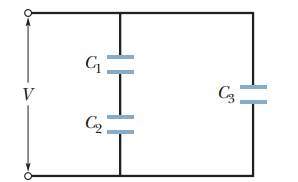
Concept explainers
In Fig. 25-28, a potential difference V = 100 V is applied across a capacitor arrangement with capacitances C1 = 10.0 μF, C2 = 5.00 μF, C3 =4.00 μF. What are (a) charge q3,(b) potential difference V3, and (c) stored energy U3 for capacitor 3, (d) q1,(e) V1, and (f) U1 for capacitor 1, and (g) q2,(h) V2, and (i) U2 for capacitor 2?

Figure 25-28 Problems 10 and 34.
Want to see the full answer?
Check out a sample textbook solution
Chapter 25 Solutions
Fundamentals Of Physics 11th Edition Loose-leaf Print Companion Volume 2 With Wileyplus Card Set
Additional Science Textbook Solutions
Applications and Investigations in Earth Science (9th Edition)
Brock Biology of Microorganisms (15th Edition)
Cosmic Perspective Fundamentals
Introductory Chemistry (6th Edition)
Principles of Anatomy and Physiology
Chemistry: An Introduction to General, Organic, and Biological Chemistry (13th Edition)
- An electric potential exists in a region of space such that V = 8x4 2y2 + 9z3 and V is in units of volts, when x, y, and z are in meters. a. Find an expression for the electric field as a function of position. b. What is the electric field at (2.0 m, 4.5 m, 2.0 m)?arrow_forwardAccording to UE=12C(V)2 (Eq. 27.3), a greater capacitance means more energy is stored by the capacitor, but according to UE = Q2/2C (Eq. 27.2), a greater capacitance means less energy is stored. How can both of these equations be correct?arrow_forwardA parallel-plate capacitor is charged and then is disconnected from the battery. By what factor does the stored energy change when the plate separation is then doubled? (a) It becomes four times larger. (b) It becomes two times larger. (c) It stays the same. (d) It becomes one-half as large. (e) It becomes one-fourth as large.arrow_forward
- (a) Regarding (lie Earth and a cloud layer 800 m above the Earth as the plates of a capacitor, calculate the capacitance of the Earth-cloud layer system. Assume the cloud layer has an area of 1.00 km2 and the air between the cloud and the ground is pure and dry'. Assume charge builds up on the cloud and on the ground until a uniform electric field of 3.00 106 N/C throughout the space between them makes the air break down and conduct electricity as a lightning bolt, (b) What is the maximum charge the cloud can hold?arrow_forwardFour particles are positioned on the rim of a circle. The charges on the particles are +0.500 C, +1.50 C, 1.00 C, and 0.500 C. If the electric potential at the center of the circle due to the +0.500 C charge alone is 4.50 104 V, what is the total electric potential at the center due to the four charges? (a) 18.0 104 V (b) 4.50 104 V (c) 0 (d) 4.50 104 V (e) 9.00 104 Varrow_forwardHow many electrons should be removed from an initially uncharged spherical conductor of radius 0.300 m to produce a potential of 7.50 kV at the surface?arrow_forward
- The dielectric to be used in a parallel-plate capacitor has a dielectric constant of 3.60 and a dielectric strength of 1.60107 V/m. The capacitor has to have a capacitance of 1.25 nF and must be able to withstand a maximum potential difference 5.5 kV. What is the minimum area the plates of the capacitor may have?arrow_forwardWhen a Leyden jar is charged by a hand generator (Fig. 27.1, page 828), the work done by the person turning the crank is stored as electric potential energy in the jar. When a capacitor is charged by a battery, where does the electric potential energy come from?arrow_forwardAn arrangement of capacitors is shown in Figure P27.23. a. If C = 9.70 105 F, what is the equivalent capacitance between points a and b? b. A battery with a potential difference of 12.00 V is connected to a capacitor with the equivalent capacitance. What is the energy stored by this capacitor? Figure P27.23 Problems 23 and 24.arrow_forward
- An electron moving parallel to the x axis has an initial speed of 3.70 106 m/s at the origin. Its speed is reduced to 1.40 105 m/s at the point x = 2.00 cm. (a) Calculate the electric potential difference between the origin and that point. (b) Which point is at the higher potential?arrow_forwardA spherical capacitor consists of a spherical conducting shell of radius b and charge 2Q that is concentric with a smaller conducting sphere of radius a and charge +Q (Fig. P20.36). (a) Show that its capacitance is C=abke(ba) (b) Show that as b approaches infinity, the capacitance approaches the value a/ke = 40a. Figure P20.36arrow_forwardFigure P26.80 shows a wire with uniform charge per unit length = 2.25 nC/m comprised of two straight sections of length d = 75.0 cm and a semicircle with radius r = 25.0 cm. What is the electric potential at point P, the center of the semicircular portion of the wire? FIGURE P26.80arrow_forward
 Physics for Scientists and Engineers: Foundations...PhysicsISBN:9781133939146Author:Katz, Debora M.Publisher:Cengage Learning
Physics for Scientists and Engineers: Foundations...PhysicsISBN:9781133939146Author:Katz, Debora M.Publisher:Cengage Learning College PhysicsPhysicsISBN:9781285737027Author:Raymond A. Serway, Chris VuillePublisher:Cengage Learning
College PhysicsPhysicsISBN:9781285737027Author:Raymond A. Serway, Chris VuillePublisher:Cengage Learning College PhysicsPhysicsISBN:9781305952300Author:Raymond A. Serway, Chris VuillePublisher:Cengage Learning
College PhysicsPhysicsISBN:9781305952300Author:Raymond A. Serway, Chris VuillePublisher:Cengage Learning Principles of Physics: A Calculus-Based TextPhysicsISBN:9781133104261Author:Raymond A. Serway, John W. JewettPublisher:Cengage Learning
Principles of Physics: A Calculus-Based TextPhysicsISBN:9781133104261Author:Raymond A. Serway, John W. JewettPublisher:Cengage Learning
 Physics for Scientists and Engineers, Technology ...PhysicsISBN:9781305116399Author:Raymond A. Serway, John W. JewettPublisher:Cengage Learning
Physics for Scientists and Engineers, Technology ...PhysicsISBN:9781305116399Author:Raymond A. Serway, John W. JewettPublisher:Cengage Learning





